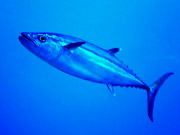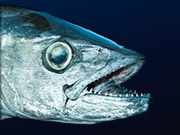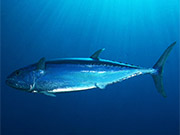The Dogtooth Tuna
The Dogtooth tuna belongs to the family of Wahoo and other Mackerel tuna. You will encounter this species mainly in the deep sea. The lucky ones could also see it in the strong currents near the reefs.
 Sometimes called White tuna or Gymnosarda unicolor by scientists and other experts, we much prefer its nickname of “Dogtooth tuna”. This name comes from its impressive jaw that presents large conical teeth. The White tuna can measures up to 8 ft and weighs around 290 lbs. This “shapely” body allows it to not fear of sharks. In spite of its large body, the dogtooth tuna can also go unnoticed in the ocean thanks to its body colors : dark blue for the upper body and silver on the flanks and the abdomen. In addition, it presents a small characteristic white spot on the top of the caudal fin. You can note that the males become blacker during the mating season in aim to seduce females.
Sometimes called White tuna or Gymnosarda unicolor by scientists and other experts, we much prefer its nickname of “Dogtooth tuna”. This name comes from its impressive jaw that presents large conical teeth. The White tuna can measures up to 8 ft and weighs around 290 lbs. This “shapely” body allows it to not fear of sharks. In spite of its large body, the dogtooth tuna can also go unnoticed in the ocean thanks to its body colors : dark blue for the upper body and silver on the flanks and the abdomen. In addition, it presents a small characteristic white spot on the top of the caudal fin. You can note that the males become blacker during the mating season in aim to seduce females.
 The dogtooth tuna feeds on small fish as Glasseyes, Anthias and calmar. It catches them by surprise or by knocking them out (performing big jump over the water and falling back in the shoal). Its body is designed for speed with small powerful fins. It may reach a speed of 80km/h thanks to 6 fins and a large crescent-moon shaped tail.
The dogtooth tuna feeds on small fish as Glasseyes, Anthias and calmar. It catches them by surprise or by knocking them out (performing big jump over the water and falling back in the shoal). Its body is designed for speed with small powerful fins. It may reach a speed of 80km/h thanks to 6 fins and a large crescent-moon shaped tail.
Younger, the dogtooth tuna moves in small groups. It becomes gradually solitary reaching adulthood. It is a curious fish often intrigued by the divers. In fact, it can get closer to you attracted by the strange bubbles that you exhale.
“ Its body is designed for speed with small powerful fins. It may reach a speed of 80km/h thanks to 6 fins and a large crescent-moon shaped tail. ”
 However, the divers have to stay vigilant in contact with this tuna because it presents a row of spines (six or seven pinnules) just next to the anal and caudal fins; a useful “accessory” to temper the enthusiasm of intrepid divers.
However, the divers have to stay vigilant in contact with this tuna because it presents a row of spines (six or seven pinnules) just next to the anal and caudal fins; a useful “accessory” to temper the enthusiasm of intrepid divers.
The dogtooth tuna lives in the Pacific Ocean, the Red Sea and the Indian Ocean as deep as 330 ft depth. You could encounter this spectacular fish during dives in the Rangiroa and Fakarava atolls !

0 Comments